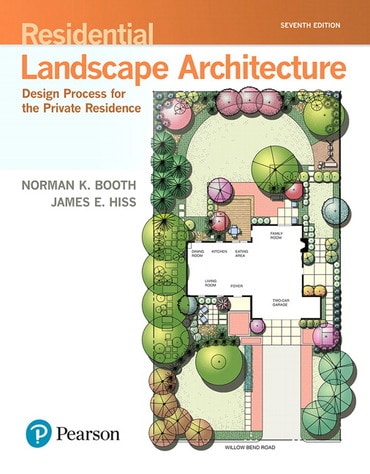
Residential Landscape Architecture: Design Process for the Private Residence, 7th edition
- Norman K. Booth |
- James E. Hiss |
Title overview
Written by two landscape architects with over 60 years of combined experience teaching the subject matter at the college level. The only text of its kind for college students, this book also serves as an ideal resource for professionals and homeowners.
Retains the content of the previous editions and provides features that improve the effectiveness of the text, including new learning objectives written to better define the learning outcomes and clearer text.
Step-by-step, in-depth explanations of each step in the process (with one chapter completely devoted to each step) provide a thorough understanding of the process.
NEW! Discussion and illustration of how concept diagrams are used in the design process as a first step in creating functional diagrams are included in an enhanced Chapter 8.
Instructional techniques for color rendering landscape drawings in pencil and on the computer provide opportunities to design with color (Chapter 15).
NEW! A new section on quick color rendering techniques that can be used to efficiently color a site plan in limited time, plus new examples of digital color rendering are included in Chapter 15.
Hundreds of graphic illustrations and many photographs provide visuals showing how to undertake each step.
NEW! Photographs of actual built landscape projects replace a number of illustrations in Chapters 2 providing real-world examples of outdoor space.
NEW! An actual design project demonstrates the overview of the design process in a completely rewritten Chapter 4. Photographs of the project before and after installation complement a completely new set of illustrations.
Case studies present a variety of alternative design solutions for each project used in the book.
A sample project running throughout the text shows each step of the design process and shows how to apply the process from start to finish.
End-of-chapter review outlines reinforce significant content and test knowledge of key points.
Discussions of special conditions and designs and new developments provide a broader understanding of the projects that designers take on. Included are:
Principles and techniques for creating a sustainable, environmentally responsible landscape in synch with natural processes (Chapter 3).
Discussion of unique site conditions on the corner, wooded, sloped, and townhouse garden sites, along with guidelines for designing each (Chapter 13).
Ideas for using alternative design solutions to stimulate creativity for different sites and clients (Chapter 14).
NEW! How to use the Internet, social media, and contemporary means of marketing and communication with clients (Chapter 5).
Learning objectives written to better define the learning outcomes and clearer text.
Discussion and illustration of how concept diagrams are used in the design process as a first step in creating functional diagrams are included in an enhanced Chapter 8.
A new section on quick color rendering techniques that can be used to efficiently color a site plan in limited time, plus new examples of digital color rendering are included in Chapter 15.
Photographs of actual built landscape projects replace a number of illustrations in Chapters 2 providing real-world examples of outdoor space.
An actual design project demonstrates the overview of the design process in a completely rewritten Chapter 4. Photographs of the project before and after installation complement a completely new set of illustrations.
How to use the Internet, social media, and contemporary means of marketing and communication with clients is covered in Chapter 5.
Table of contents
Author bios
Norman K. Booth is Professor Emeritus, The Ohio State University, where he taught landscape architecture for over 31 years. Booth’s specialty was teaching introductory design and graphic courses in both the graduate and undergraduate programs. He also participated in teaching a series of five short courses on residential landscape design for over 20 years through The Ohio State Extension Service and in Arizona, California, Georgia, Washington, and Wisconsin. He served on the UNE and LARE committees for the Council of Landscape Architectural Registration Boards (CLARB) and participated in accreditation teams for the ASLA Landscape Architectural Accreditation Board (LAAB). He is the author of Basic Elements of Landscape Architecture (Waveland Press, 1990) and Foundations of Landscape Architecture (Wiley, 2012).
James E. Hiss is Associate Professor Emeritus, The Ohio State University, where he taught landscape architecture for over 28 years. His specialty was teaching residential site design, graphics, and construction courses in both the graduate and undergraduate programs. He also participated in teaching a series of five short courses on residential landscape design through The Ohio State Extension Service and in Arizona, Maryland, Ohio, Pennsylvania, Utah, and Wisconsin. He is the author of Perspectives: An Effective Design Tool (ASLA, Landscape Architecture Foundation, 1985) and taught perspective drawing workshops in California, Colorado, Georgia, Hawaii, Ohio, Oklahoma, Texas, and Washington, DC. He retired from The Ohio State University in 2003 and co-founded The EDGE Group, a landscape architecture and planning firm, with offices in Columbus and Toledo, OH and Nashville, TN. He retired from The EDGE Group in 2013. He established Places + Spaces, LLC, where he continues part-time residential site design along with his writing efforts.